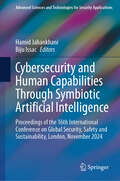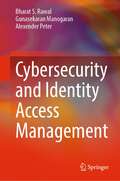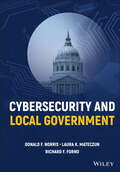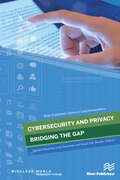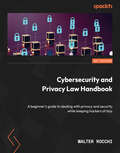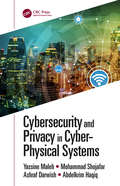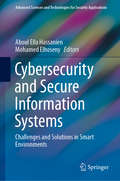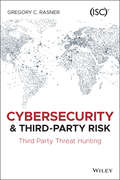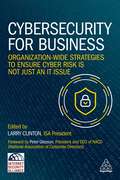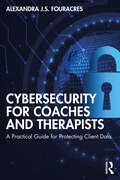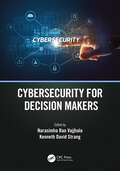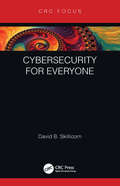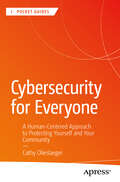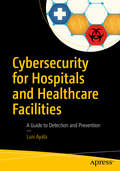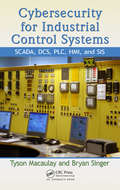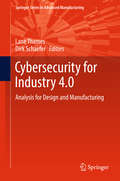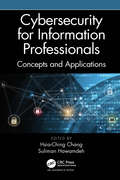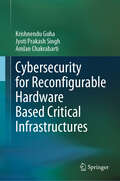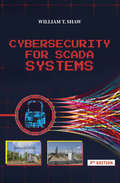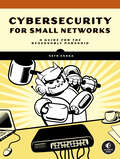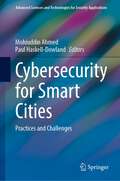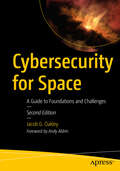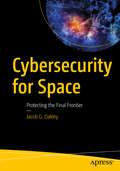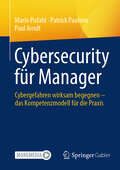- Table View
- List View
Cybersecurity and Human Capabilities Through Symbiotic Artificial Intelligence: Proceedings of the 16th International Conference on Global Security, Safety and Sustainability, London, November 2024 (Advanced Sciences and Technologies for Security Applications)
by Hamid Jahankhani Biju IssacThis book presents the 16th ICGS3-24 conference which aims to understand the full impact of cyber-security, AI, deepfake, and quantum computing on humanity. Over the last two decades, technology relating to cyber-space (satellites, drones, UAVs), cyber-security, artificial intelligence, and generative AI has evolved rapidly. Today, criminals have identified rewards from online frauds; therefore, the risks and threats of cyber-attacks have increased too. Detection of the threat is another strand to the strategy and will require dynamic risk management techniques, strong and up-to-date information governance standards, and frameworks with AI responsive approaches in order to successfully monitor and coordinate efforts between the parties. Thus, the ability to minimize the threats from cyber is an important requirement. This will be a mission-critical aspect of the strategy with development of the right cyber-security skills, knowledge, and culture that are imperative for the implementation of the cyber-strategies. As a result, the requirement for how AI Demand will influence business change and thus influence organizations and governments is becoming important. In an era of unprecedented volatile, political, and economic environment across the world, computer-based systems face ever more increasing challenges, disputes, and responsibilities while the Internet has created a global platform for the exchange of ideas, goods, and services; however, it has also created boundless opportunities for cyber-crime. The ethical and legal implications of connecting the physical and digital worlds and presenting the reality of a truly interconnected society present the realization of the concept of smart societies. Drawing on 15 years of successful events, the 16th ICGS3-24 conference aims to provide attendees with an information-packed agenda with representatives from across the industry and the globe. This Annual International Conference is an established platform in which security, safety, and sustainability issues can be examined from several global perspectives through dialogue between academics, students, government representatives, chief executives, security professionals, and research scientists from the UK and from around the globe.
Cybersecurity and Identity Access Management
by Bharat S. Rawal Gunasekaran Manogaran Alexender PeterThis textbook provides a comprehensive, thorough and up-to-date treatment of topics in cyber security, cyber-attacks, ethical hacking, and cyber crimes prevention. It discusses the different third-party attacks and hacking processes which a poses a big issue in terms of data damage or theft. The book then highlights the cyber security protection techniques and overall risk assessments to detect and resolve these issues at the beginning stage to minimize data loss or damage. This book is written in a way that it presents the topics in a simplified holistic and pedagogical manner with end-of chapter exercises and examples to cater to undergraduate students, engineers and scientists who will benefit from this approach.
Cybersecurity and Local Government
by Donald F. Norris Laura K. Mateczun Richard F. FornoCYBERSECURITY AND LOCAL GOVERNMENT Learn to secure your local government’s networks with this one-of-a-kind resource In Cybersecurity and Local Government, a distinguished team of researchers delivers an insightful exploration of cybersecurity at the level of local government. The book makes a compelling argument that every local government official, elected or otherwise, must be reasonably knowledgeable about cybersecurity concepts and provide appropriate support for it within their governments. It also lays out a straightforward roadmap to achieving those objectives, from an overview of cybersecurity definitions to descriptions of the most common security challenges faced by local governments. The accomplished authors specifically address the recent surge in ransomware attacks and how they might affect local governments, along with advice as to how to avoid and respond to these threats. They also discuss the cybersecurity law, cybersecurity policies that local government should adopt, the future of cybersecurity, challenges posed by Internet of Things, and much more. Throughout, the authors provide relevant field examples, case studies of actual local governments, and examples of policies to guide readers in their own application of the concepts discussed within. Cybersecurity and Local Government also offers: A thorough introduction to cybersecurity generally, including definitions of key cybersecurity terms and a high-level overview of the subject for non-technologists. A comprehensive exploration of critical information for local elected and top appointed officials, including the typical frequencies and types of cyberattacks. Practical discussions of the current state of local government cybersecurity, with a review of relevant literature from 2000 to 2021. In-depth examinations of operational cybersecurity policies, procedures and practices, with recommended best practices. Perfect for local elected and top appointed officials and staff as well as local citizens, Cybersecurity and Local Government will also earn a place in the libraries of those studying or working in local government with an interest in cybersecurity.
Cybersecurity and Privacy - Bridging the Gap (River Publishers Series In Communications Ser.)
by Lene Tolstrup Sørensen Knud Erik Skouby Samant KhajuriaThe huge potential in future connected services has as a precondition that privacy and security needs are dealt with in order for new services to be accepted. This issue is increasingly on the agenda both at company and at individual level. Cybersecurity and Privacy - bridging the gap addresses two very complex fields of the digital world, i.e., Cybersecurity and Privacy. These multifaceted, multidisciplinary and complex issues are usually understood and valued differently by different individuals, data holders and legal bodies. But a change in one field immediately affects the others. Policies, frameworks, strategies, laws, tools, techniques, and technologies - all of these are tightly interwoven when it comes to security and privacy. This book is another attempt to bridge the gap between the industry and academia. The book addresses the views from academia and industry on the subject.
Cybersecurity and Privacy Law Handbook: A beginner's guide to dealing with privacy and security while keeping hackers at bay
by Walter RocchiGet to grips with cybersecurity and privacy laws to protect your company's data and comply with international privacy standardsKey FeaturesComply with cybersecurity standards and protect your data from hackersFind the gaps in your company's security posture with gap analysis and business impact analysisUnderstand what you need to do with security and privacy without needing to pay consultantsBook DescriptionCybercriminals are incessantly coming up with new ways to compromise online systems and wreak havoc, creating an ever-growing need for cybersecurity practitioners in every organization across the globe who understand international security standards, such as the ISO27k family of standards. If you're looking to ensure that your company's data conforms to these standards, Cybersecurity and Privacy Law Handbook has got you covered. It'll not only equip you with the rudiments of cybersecurity but also guide you through privacy laws and explain how you can ensure compliance to protect yourself from cybercrime and avoid the hefty fines imposed for non-compliance with standards. Assuming that you're new to the field, this book starts by introducing cybersecurity frameworks and concepts used throughout the chapters. You'll understand why privacy is paramount and how to find the security gaps in your company's systems. There's a practical element to the book as well—you'll prepare policies and procedures to prevent your company from being breached. You'll complete your learning journey by exploring cloud security and the complex nature of privacy laws in the US. By the end of this cybersecurity book, you'll be well-placed to protect your company's data and comply with the relevant standards.What you will learnStrengthen the cybersecurity posture throughout your organizationUse both ISO27001 and NIST to make a better security frameworkUnderstand privacy laws such as GDPR, PCI CSS, HIPAA, and FTCDiscover how to implement training to raise cybersecurity awarenessFind out how to comply with cloud privacy regulationsExamine the complex privacy laws in the USWho this book is forIf you're a seasoned pro with IT security and / or cybersecurity, this book isn't for you. This book is aimed at novices, freshers, students, experts in other fields, and managers, that, are willing to learn, understand, and manage how a security function is working, especially if you need to be. Although the reader will be able, by reading this book, to build and manage a security function on their own, it is highly recommended to supervise a team devoted to implementing cybersecurity and privacy practices in an organization.
Cybersecurity and Privacy in Cyber Physical Systems
by Yassine Maleh Shojafar Mohammad Darwish Ashraf Haqiq AbdelkrimCybersecurity and Privacy in Cyber-Physical Systems collects and reports on recent high-quality research that addresses different problems related to cybersecurity and privacy in cyber-physical systems (CPSs). It Presents high-quality contributions addressing related theoretical and practical aspects Improves the reader’s awareness of cybersecurity and privacy in CPSs Analyzes and presents the state of the art of CPSs, cybersecurity, and related technologies and methodologies Highlights and discusses recent developments and emerging trends in cybersecurity and privacy in CPSs Proposes new models, practical solutions, and technological advances related to cybersecurity and privacy in CPSs Discusses new cybersecurity and privacy models, prototypes, and protocols for CPSs This comprehensive book promotes high-quality research by bringing together researchers and experts in CPS security and privacy from around the world to share their knowledge of the different aspects of CPS security. Cybersecurity and Privacy in Cyber-Physical Systems is ideally suited for policymakers, industrial engineers, researchers, academics, and professionals seeking a thorough understanding of the principles of cybersecurity and privacy in CPSs. They will learn about promising solutions to these research problems and identify unresolved and challenging problems for their own research. Readers will also have an overview of CPS cybersecurity and privacy design.
Cybersecurity and Secure Information Systems: Challenges and Solutions in Smart Environments (Advanced Sciences and Technologies for Security Applications)
by Aboul Ella Hassanien Mohamed ElhosenyThis book provides a concise overview of the current state of the art in cybersecurity and shares novel and exciting ideas and techniques, along with specific cases demonstrating their practical application. It gathers contributions by both academic and industrial researchers, covering all aspects of cybersecurity and addressing issues in secure information systems as well as other emerging areas. The content comprises high-quality research articles and reviews that promote a multidisciplinary approach and reflect the latest advances, challenges, requirements and methodologies. Thus, the book investigates e.g. security vulnerabilities, cybercrime, and privacy issues related to big data analysis, as well as advances in digital forensics, secure smart city services, and risk mitigation strategies for devices employing cyber-physical systems. Given its scope, the book offers a valuable resource for students, researchers, IT professionals and providers, citizens, consumers and policymakers involved or interested in the modern security procedures needed to protect our information and communication resources. Its goal is to foster a community committed to further research and education, and one that can also translate its findings into concrete practices.
Cybersecurity and Third-Party Risk: Third Party Threat Hunting
by Gregory C. RasnerSTRENGTHEN THE WEAKEST LINKS IN YOUR CYBERSECURITY CHAINAcross the world, the networks of hundreds of different world-class organizations have been breached in a seemingly never-ending stream of attacks that targeted the trusted vendors of major brands. From Target to Equifax, Home Depot, and GM, it seems as if no company is safe from a third-party incident or breach, regardless of size. And the advanced threats are now exploiting the intersection of weaknesses in cybersecurity and third-party risk management.In Cybersecurity and Third-Party Risk, veteran cybersecurity specialist Gregory Rasner walks readers through how to lock down the vulnerabilities posed to an organization’s network by third parties. You’ll discover how to move beyond a simple checklist and create an active, effective, and continuous system of third-party cybersecurity risk mitigation.The author discusses how to conduct due diligence on the third parties connected to your company’s networks and how to keep your information about them current and reliable. You’ll learn about the language you need to look for in a third-party data contract whether you’re offshoring or outsourcing data security arrangements.Perfect for professionals and executives responsible for securing their organizations’ systems against external threats, Cybersecurity and Third-Party Risk is an indispensable resource for all business leaders who seek to:Understand the fundamentals of third-party risk managementConduct robust intake and ongoing due diligencePerform on-site due diligence and close vendor risksSecure your software supply chainUtilize cloud and on-premises software securelyContinuously monitor your third-party vendors and prevent breaches
Cybersecurity for Beginners
by Raef MeeuwisseThis book provides an easy insight into the essentials of cybersecurity, even if you have a non-technical background. You may be a business person keen to understand this important subject area or an information security specialist looking to update your knowledge. <p><p>The world has changed more in the past 10 years than in any 10 year period in human history... Technology is no longer a peripheral servant, it shapes our daily lives. Companies that can use technology wisely and well are booming, companies that make bad or no technology choices collapse and disappear. <p><p>The cloud, smart devices and the ability to connect almost any object to the internet are an essential landscape to use but are also fraught with new risks and dangers of a magnitude never seen before. <p><p>Also featuring an alphabetical section at the back of the book to help you translate many of the main cybersecurity technical terms into plain, non-technical English. This is the second edition of this book with updates and additional content. If you are looking for a book on personal cybersecurity steps, try my other publication "How to Keep Your Stuff Safe Online"
Cybersecurity for Business: Organization-Wide Strategies to Ensure Cyber Risk Is Not Just an IT Issue
by Larry ClintonBalance the benefits of digital transformation with the associated risks with this guide to effectively managing cybersecurity as a strategic business issue. Important and cost-effective innovations can substantially increase cyber risk and the loss of intellectual property, corporate reputation and consumer confidence. Over the past several years, organizations around the world have increasingly come to appreciate the need to address cybersecurity issues from a business perspective, not just from a technical or risk angle. Cybersecurity for Business builds on a set of principles developed with international leaders from technology, government and the boardroom to lay out a clear roadmap of how to meet goals without creating undue cyber risk.This essential guide outlines the true nature of modern cyber risk, and how it can be assessed and managed using modern analytical tools to put cybersecurity in business terms. It then describes the roles and responsibilities each part of the organization has in implementing an effective enterprise-wide cyber risk management program, covering critical issues such as incident response, supply chain management and creating a culture of security. Bringing together a range of experts and senior leaders, this edited collection enables leaders and students to understand how to manage digital transformation and cybersecurity from a business perspective.
Cybersecurity for Coaches and Therapists: A Practical Guide for Protecting Client Data
by Alexandra J.S. FouracresThis groundbreaking book filters down the wealth of information on cybersecurity to the most relevant and highly applicable aspects for coaches, therapists, researchers and all other practitioners handling confidential client conversations and data. Whether working with clients online or face to face, practitioners today increasingly rely on the cyberspace as part of their practice. Through a solutions-focused lens, the book provides easy-to-apply practical advice and guidelines using non-technical language, enabling practitioners to mitigate the rising threat of cybercrime, which can no longer be ignored. By the last page the reader will have knowledge and awareness towards: securing devices, spotting financial fraud, mitigating the risks of online communications, operating more securely from a home office and handling a cyber event if one occurs. Clear, concise, and easy to follow, this guide is a pivotal resource for coaches, therapists, researchers and all other practitioners protecting their clients and businesses.
Cybersecurity for Decision Makers
by Narasimha Rao Vajjhala Kenneth David Strang Cybersecurity Decision MakersThis book is aimed at managerial decision makers, practitioners in any field, and the academic community. The chapter authors have integrated theory with evidence-based practice to go beyond merely explaining cybersecurity topics. To accomplish this, the editors drew upon the combined cognitive intelligence of 46 scholars from 11 countries to present the state of the art in cybersecurity. Managers and leaders at all levels in organizations around the globe will find the explanations and suggestions useful for understanding cybersecurity risks as well as formulating strategies to mitigate future problems. Employees will find the examples and caveats both interesting as well as practical for everyday activities at the workplace and in their personal lives. Cybersecurity practitioners in computer science, programming, or espionage will find the literature and statistics fascinating and more than likely a confirmation of their own findings and assumptions. Government policymakers will find the book valuable to inform their new agenda of protecting citizens and infrastructure in any country around the world. Academic scholars, professors, instructors, and students will find the theories, models, frameworks, and discussions relevant and supportive to teaching as well as research.
Cybersecurity for Everyone
by David B. SkillicornCyberspace is a critical part of our lives. Although we all use cyberspace for work, entertainment, and social life, much of its infrastructure and operation is invisible to us. We spend a big part of our lives in an environment that is almost an essential service but is full of potential dangers: a place where criminals can commit new kinds of crimes, where governments can exert political pressure, and where we can be hurt by the unthinking actions of the bored and careless. Making cyberspace more secure is one of the challenges of our times. This is not only (or perhaps even primarily) a technical challenge. It requires actions by governments and businesses to encourage security whenever possible, and to make sure that their own actions do not undermine it. Unfortunately, many of those in a position to do something about cybersecurity do not have the background to understand the issues fully. Cybersecurity for Everyone will help by describing the issues in a way that is accessible to anyone, but especially those from non-technical backgrounds.
Cybersecurity for Everyone: A Human-Centered Approach to Protecting Yourself and Your Community (Apress Pocket Guides)
by Cathy OlieslaegerIn a world where cyber threats are growing exponentially in number and complexity, it&’s time to ask the tough question: What are we doing wrong? We&’ve been tackling cybersecurity the same way for years, yet the bad actors continue to stay ahead. Financial losses mount, and the talent gap in the cybersecurity industry remains a persistent challenge. It&’s time to break the cycle. This book takes a bold, fresh look at cybersecurity by shifting the focus away from the technical jargon and putting the spotlight on the people who matter most—you. Whether you&’re a student, a professional, a parent, or a business leader, this book is designed to help you understand cybersecurity&’s role in everyday life and how you can make a difference. From the classroom to the boardroom, there&’s a shared responsibility in keeping our digital world safe. Unlike traditional cybersecurity books filled with complex terminology and tech-heavy concepts, this book humanizes the topic. It provides practical, real-world solutions for protecting yourself, your family, your workplace, and your community. You&’ll learn not just the how but also the why—why cybersecurity matters and why it's a people-first issue that concerns all of us, regardless of our background or profession. Whether you&’re just starting your cybersecurity journey or you're looking to build a security-first culture within your organization, this book equips you with the knowledge and confidence to make an impact. With a focus on democratizing cybersecurity knowledge, this guide is your call to action, offering accessible insights to foster a more secure digital future for everyone. What You Will Learn Protect yourself and the people you care about Journey into cybersecurity without having to break anything Educate students about keeping safe in the digital world Build bridges between the educational and professional worlds Establish a cybersecurity cultrure as a bsiness leader Who This Book Is For Whether you&’re a student, professional, parent, or business leader, this book is designed to help you understand cybersecurity&’s role in everyday life and how you can make a difference. From the classroom to the boardroom, there&’s a shared responsibility in keeping our digital world safe.
Cybersecurity for Hospitals and Healthcare Facilities: A Guide to Detection and Prevention
by Luis AyalaLearn how to detect and prevent the hacking of medical equipment at hospitals and healthcare facilities. A cyber-physical attack on building equipment pales in comparison to the damage a determined hacker can do if he/she gains access to a medical-grade network as a medical-grade network controls the diagnostic, treatment, and life support equipment on which lives depend. News reports inform us how hackers strike hospitals with ransomware that prevents staff from accessing patient records or scheduling appointments. Unfortunately, medical equipment also can be hacked and shut down remotely as a form of extortion. Criminal hackers will not ask for a $500 payment to unlock an MRI, PET or CT scan, or X-ray machine--they will ask for much more. Litigation is bound to follow and the resulting punitive awards will drive up hospital insurance costs and healthcare costs in general. This will undoubtedly result in increased regulations for hospitals and higher costs for compliance. Unless hospitals and other healthcare facilities take the steps necessary to secure their medical-grade networks, they will be targeted for cyber-physical attack, possibly with life-threatening consequences. Cybersecurity for Hospitals and Healthcare Facilities is a wake-up call explaining what hackers can do, why hackers would target a hospital, the way hackers research a target, ways hackers can gain access to a medical-grade network (cyber-attack vectors), and ways hackers hope to monetize their cyber-attack. By understanding and detecting the threats, you can take action now--before your hospital becomes the next victim. What You Will Learn: Determine how vulnerable hospital and healthcare building equipment is to cyber-physical attack Identify possible ways hackers can hack hospital and healthcare facility equipment Recognize the cyber-attack vectors--or paths by which a hacker or cracker can gain access to a computer, a medical-grade network server, or expensive medical equipment in order to deliver a payload or malicious outcome Detect and prevent man-in-the-middle or denial-of-service cyber-attacks Detect and prevent hacking of the hospital database and hospital web application Who This Book Is For: Hospital administrators, healthcare professionals, hospital & healthcare facility engineers and building managers, hospital & healthcare facility IT professionals, and HIPAA professionals
Cybersecurity for Industrial Control Systems: SCADA, DCS, PLC, HMI, and SIS
by Tyson Macaulay Bryan L. SingerAs industrial control systems (ICS), including SCADA, DCS, and other process control networks, become Internet-facing, they expose crucial services to attack. Threats like Duqu, a sophisticated worm found in the wild that appeared to share portions of its code with the Stuxnet worm, emerge with increasing frequency. Explaining how to develop and im
Cybersecurity for Industry 4.0: Analysis for Design and Manufacturing (Springer Series in Advanced Manufacturing)
by Dirk Schaefer Lane ThamesThis book introduces readers to cybersecurity and its impact on the realization of the Industry 4. 0 vision. It covers the technological foundations of cybersecurity within the scope of the Industry 4. 0 landscape and details the existing cybersecurity threats faced by Industry 4. 0, as well as state-of-the-art solutions with regard to both academic research and practical implementations. Industry 4. 0 and its associated technologies, such as the Industrial Internet of Things and cloud-based design and manufacturing systems are examined, along with their disruptive innovations. Further, the book analyzes how these phenomena capitalize on the economies of scale provided by the Internet. The book offers a valuable resource for practicing engineers and decision makers in industry, as well as researchers in the design and manufacturing communities and all those interested in Industry 4. 0 and cybersecurity.
Cybersecurity for Information Professionals: Concepts and Applications
by Hsia-Ching ChangInformation professionals have been paying more attention and putting a greater focus on privacy over cybersecurity. However, the number of both cybersecurity and privacy breach incidents are soaring, which indicates that cybersecurity risks are high and growing. Utilizing cybersecurity awareness training in organizations has been an effective tool to promote a cybersecurity-conscious culture, making individuals more cybersecurity-conscious as well. However, it is unknown if employees’ security behavior at work can be extended to their security behavior at home and personal life. On the one hand, information professionals need to inherit their role as data and information gatekeepers to safeguard data and information assets. On the other hand, information professionals can aid in enabling effective information access and dissemination of cybersecurity knowledge to make users conscious about the cybersecurity and privacy risks that are often hidden in the cyber universe. Cybersecurity for Information Professionals: Concepts and Applications introduces fundamental concepts in cybersecurity and addresses some of the challenges faced by information professionals, librarians, archivists, record managers, students, and professionals in related disciplines. This book is written especially for educators preparing courses in information security, cybersecurity, and the integration of privacy and cybersecurity. The chapters contained in this book present multiple and diverse perspectives from professionals in the field of cybersecurity. They cover such topics as: Information governance and cybersecurity User privacy and security online and the role of information professionals Cybersecurity and social media Healthcare regulations, threats, and their impact on cybersecurity A socio-technical perspective on mobile cybersecurity Cybersecurity in the software development life cycle Data security and privacy Above all, the book addresses the ongoing challenges of cybersecurity. In particular, it explains how information professionals can contribute to long-term workforce development by designing and leading cybersecurity awareness campaigns or cybersecurity hygiene programs to change people’s security behavior.
Cybersecurity for Reconfigurable Hardware Based Critical Infrastructures
by Amlan Chakrabarti Jyoti Prakash Singh Krishnendu GuhaThe book commences with an introductory section on reconfigurable computing and thereafter delves into its applications in critical infrastructures. This book analyzes how such systems may be affected due to vulnerabilities and also discusses how these can be attacked by adversaries or cybercriminals. This book also discusses protection mechanisms related to such threats. It initially starts with an introduction to the various industrial revolutions and the changes in security needs, followed by a basic description of reconfigurable hardware based critical infrastructures. Further, the book contains discussion on security administration and planning, auditing, monitoring and analysis, risk-response and recovery, control and countermeasures highlighting their need in reconfigurable hardware-based platforms. In addition to these, new concepts are introduced such as AI/ML for cybersecurity, digital forensics related to reconfigurable hardware based critical infrastructures. Finally, a hands on learning experience is presented to provide the readers with a practical flavour. The book will be useful to students (graduate and undergraduate), researchers, academicians and industry professionals.
Cybersecurity for SCADA Systems
by William T. ShawThe world has changed since the first edition was published in 2006. There have been many technological changes in communications and networking and in other areas of computer science. More focus is given to implementing cybersecurity protections and technical countermeasures. The second edition also takes advantage of the evolved industry-specific cybersecurity standards that have emerged, especially in the electric power and oil-and-gas pipeline industry sectors. Cybersecurity for SCADA Systems, 2nd Edition is intended to provide a general background of SCADA system technology and cybersecurity concepts and technologies, showing how the two can be brought together to safeguard our infrastructure and computer automation systems. This book provides a high-level overview of this unique technology, with an explanation of each market segment. Readers will understand the vital issues and learn strategies for decreasing or eliminating system vulnerabilities. Cybersecurity for SCADA Systems, 2nd Edition is suitable for nontechnical, management-level personnel as well as IT personnel without SCADA experience. Features and Benefits Functional breakdown and explanation of the typical features, capabilities, and components of a SCADA system IT and cybersecurity technology and terminology overview and explanation Industry-specific as well as generalized discussion of SCADA vulnerabilities and available remediation strategies Discussion of physical and electronic security issues and strategies Audience IT personnel Management Students
Cybersecurity for Small Networks: A No-Nonsense Guide for the Reasonably Paranoid
by Seth EnokaA guide to implementing DIY security solutions and readily available technologies to protect home and small-office networks from attack.This book is an easy-to-follow series of tutorials that will lead readers through different facets of protecting household or small-business networks from cyber attacks. You&’ll learn how to use pfSense to build a firewall, lock down wireless, segment a network into protected zones, configure a VPN (virtual private network) to hide and encrypt network traffic and communications, set up proxies to speed up network performance and hide the source of traffic, block ads, install and configure an antivirus, back up your data securely, and even how to monitor your network for unauthorized activity and alert you to intrusion.
Cybersecurity for Smart Cities: Practices and Challenges (Advanced Sciences and Technologies for Security Applications)
by Mohiuddin Ahmed Paul Haskell-DowlandEnsuring cybersecurity for smart cities is crucial for a sustainable cyber ecosystem. Given the undeniable complexity of smart cities, fundamental issues such as device configurations and software updates should be addressed when it is most needed to fight cyber-crime and ensure data privacy. This book addresses the cybersecurity challenges associated with smart cities, aiming to provide a bigger picture of the concepts, intelligent techniques, practices and research directions in this area. Furthermore, this book serves as a single source of reference for acquiring knowledge on the technology, processes and people involved in the next-generation of cyber-smart cities.
Cybersecurity for Space: A Guide to Foundations and Challenges
by Jacob G. OakleySpace is one of the fastest growing military, government and industry sectors. Because everything in today’s world exists within or connected to cyberspace, there is a dire need to ensure cybersecurity is addressed in the burgeoning field of space operations. This revised and expanded edition will prime the reader with the knowledge needed to understand the unique challenges to space operations which affect the implementation of cybersecurity. Further, the reader will have foundational knowledge on what impacts cyber threats can have on space systems and how cybersecurity must rise to meet them. The author, who spent years in the United States Marine Corps, originally involved in satellite communications is now a seasoned cyber security practitioner who has provided cyber security vision and strategy to a large portfolio of systems and programs, many focused specifically in space. A published academic and experienced professional, he brings a practical, real-world and tempered approach to securing the final frontier. What You Will Learn Basic concepts of how different space vehicles operate in general. How such systems and their components integrate into cyberspace. A clear picture of the potential damage available via cyber-attacks to such systems. Basic efforts to mitigate such cyber threats will be presented through the various portions of space operations. Foundational issues at the intersection of the space and cyber domains Who This Book Is For This book is written for anyone curious about warfare in the era of cyber everything, those involved in cyber operations and cyber warfare, as well as security practitioners and policy or decision makers who are on the sending or receiving end of such activity.
Cybersecurity for Space: Protecting the Final Frontier
by Jacob G. OakleyThis is the first book of its kind to cover the unique challenges of creating, maintaining, and operating a system that operates in both outer space and cyber space. It covers the impact that cyber threats can have on space systems and how the cybersecurity industry must rise to meet the threats. Space is one of the fastest growing military, government, and industry sectors. Because everything in today’s world exists within or connected to cyberspace, there is a dire need to ensure that cybersecurity is addressed in the burgeoning field of space operations. You will be introduced to the basic concepts involved in operating space systems that include low earth orbit (LEO), geosynchronous orbit (GEO), and others. Using the related high-level constraints, threats, and vectors, you will be able to frame a clear picture of the need and challenges of bringing cybersecurity to bear on satellites, space vehicles, and their related systems. The author, who has spent seven years in the US Marine Corps and was originally involved in satellite communications and later cyber operations, is now a seasoned cybersecurity practitioner currently implementing cybersecurity vision and strategy to a large portfolio of systems and programs, many focused specifically in space. A published academic and experienced professional, he brings a practical, real-world and tempered approach to securing space vehicles and their systems. What You Will Learn Understand what constitutes a space system and the challenges unique to operations of all spacecraftGet introduced to various space vehicles and their unique constraints and challengesBe aware of the physical and cyber threats to the space vehicle and its ability to fly and orbitKnow the physical and cyber vectors from which threats may manifestStudy the micro- and macro-analysis provided of space system attack scenariosBe familiar with the high-level problems of cybersecurity in the space domain Who This Book Is For This book is written for two audiences: those with a background in space operations as well as those in cybersecurity. It offers the guidance needed to understand the unique challenges to space operations that affect the implementation of cybersecurity.
Cybersecurity für Manager: Cybergefahren wirksam begegnen – das Kompetenzmodell für die Praxis
by Mario Pufahl Patrick Paulsen Paul ArndtDieses Buch erklärt verständlich, was Cyber Security ist und wie Unternehmen der Bedrohungslage im Internet effektiv begegnen können. Entscheidungsträger erhalten leicht verständliche Denkanstöße und können sich anhand eines methodischen Rahmens Schritt für Schritt diesem zentralen Thema nähern und es besser durchdringen – die Voraussetzung, um gemeinsam mit IT- und Cyber-Security-Experten bessere operative Entscheidungen zu treffen. Die Bedeutung von Cyber Security nimmt von zu Tag Tag zu, da immer mehr Firmen gegen ihren Willen digital attackiert werden. Dies bringt das Thema auf den Tisch der Geschäftsführungen.In diesem Buch wird das Thema Cyber Security, das technisch sehr komplex und für IT-Laien schwer verständlich sein kann, auf eine verständliche Art und Weise dargestellt.
